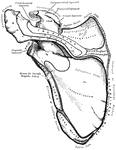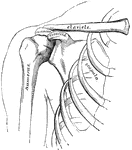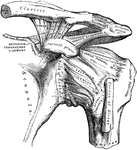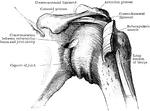Clipart tagged: ‘shoulder’
Veins of the Arm and Shoulder
Veins of the upper extremity . Labels: 1, axillary artery; 2, axillary veins; 3, 4, basilic; 5, point…

Arteries
"The Right Axillary and Branchial Arteries, with Some of their Main Branches." — Blaisedell, 1904

Muscles of the Back and Shoulder
"Some of the Larger Muscles on the Back of the Shoulder and the Arm." — Blaisedell, 1904

Bones of the Shoulder and Upper Extremity - Front View
"A, acromion; C, coracoid; CA, carpus; CL, clavicle; H, humerus; M, metacarpals; O, ventral surface…

Clavicle and Scapula with Ligament
Right clavicle and scapula with ligament, from without and somewhat in front.
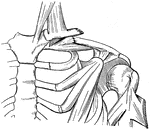
Broken Clavicle
"When a bone is broken, blood trickles out between the incjured parts, and afterwards gives place to…

Red-Shouldered Hawk
Also known as the winter falcon, is found in California, Wisconsin, and South Carolina.
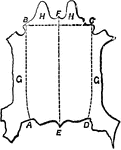
Hide Divisions
"The hides now come to be trimmed and prepared for tanning in the shape in which they are intended ultimately…
Left Shoulder, Arms
"Carry the piece with the right hand and place it on the left shoulder, barrel up, trigger guard in…

Greek Lekythos
This Greek Lekythos is made of red clay and painted in black. The form is elongated and cylindrical,…

Greek Lekythos
This Greek Lekythos is made of red clay and painted in black. The form is elongated and cylindrical,…
Greek Lekythos
This Greek Lekythos is made of red clay and painted in black. The form is elongated and cylindrical,…

Greek Lekythos
This Greek Lekythos is made of red clay and painted in black. The form is elongated and cylindrical,…

Greek Lekythos
This Greek Lekythos is made of red clay and painted in black. The form is elongated and cylindrical,…

Greek Lekythos
This Greek Lekythos is made of red clay and painted in black. The form is elongated and cylindrical,…

Greek Lekythos
This Greek Lekythos is painted in black and white. The form is elongated and cylindrical, while the…

Greek Lekythos
This Greek Lekythos has an attic style. The form is elongated and cylindrical, while the neck is long…

Greek Lekythos
This Greek Lekythos has an attic style. The form is elongated and cylindrical, while the neck is long…

Greek Lekythos
This Greek Lekythos is made of red clay and painted in black. The form is elongated and cylindrical,…

Greek Lekythos
This Greek Lekythos is made of red clay and painted in black. The form is elongated and cylindrical,…

Greek Lekythos
This Greek Lekythos is made of red clay and painted in black. The form is elongated and cylindrical,…

Greek Lekythos
This Greek Lekythos is painted in black and white. The form is elongated and cylindrical, while the…
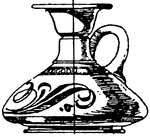
Greek Lekythos
This Greek Lekythos has an elongated and cylindrical form with a long neck. Its a type of Greek pottery…

Micrometer
"A plan of this slide; the divided drum of the screw is omitted for sale of clearness. The screw S has…
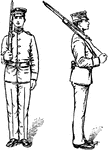
Right Shoulder, Arms
"Without changing the grasp of the right hand, place the piece on the right shoulder, barrel up and…

Scapula
"The shoulder-blade is a large, flat, three-sided bone, which is placed on the upper and back…

The Human Scapula
The human scapula bone (shoulder blade). Labels: 1, glenoid cavity; 2, end of the spine of scapula.

Shoulder
The left shoulder-joint, scapuloclavicular articulations, and proper ligaments of the scapula.

Sagittal Section Through Shoulder and Lung
Sagittal section through left shoulder, lung, and apex of the heart.
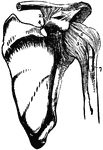
Bones and Ligaments of the Shoulder Articulation
Ligaments of the acromio-clavicular and scapulo-humeral articulations (joints of the shoulder). Labels:…
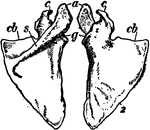
Shoulder blade
"The Scapula, or shoulder blade, is one of the two bones, the other being the clavicle, which form the…
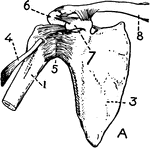
Shoulder bones and ligaments
"Shoulder bones and ligaments. 1. Humerus, 3. Scapula, 4. Tendon of biceps 5. Capsular ligament 6. Acromion…

Capsular Ligament of the Shoulder Joint
Capsular ligament of the shoulder joint cut across and humerus removed.
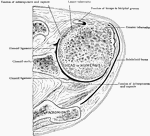
Horizontal Section Through Shoulder Joint
Horizontal section through the right shoulder joint from above.

Frontal Section Through the Shoulder
Frontal section of the right shoulder through the middle of the humeral head. Section passes through…
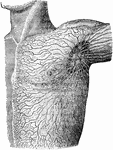
Lymphatics of the Shoulder
Lymphatics and lymphatic glands on the left side of the body and shoulder.

Nerves of the Shoulder
Showing the dorsal preaxial origin of the musculospiral (radial) nerve, and the ventral post-axial origin…

A Collection of Spectacles
"A, spectacles with bows hinged to the shoulders on the rims connected by the nose or bridge. B, spectacles…
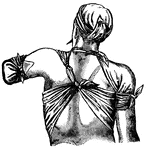
Triangular Bandage
This illustration shows a method of applying a triangular bandage to the chest, shoulder, head and elbow.

Cross Section Through the Trunk at the Neck
Section through the neck immediately above the shoulders.

Cross Section Through the Trunk at the Shoulders
Section through the thyroid gland and the upper borders of the shoulders.

